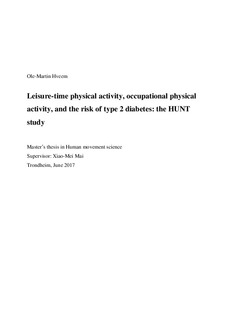| dc.description.abstract | Background: Type 2 diabetes has become one of the major health concerns in the world, with its prevalence growing over the last decades. Previous studies have shown that leisure-time physical activity may reduce the risk of developing type 2 diabetes, and that there may be a dose-response relationship. However, not many studies have looked at the potential benefits of occupational physical activity. Therefore, the aims of our study were to investigate both leisure-time and occupational physical activity in association to risk of type 2 diabetes and how they modify each other’s association in a young to middle-aged adult population.
Methods: We investigated 18 734 diabetes-free participants based on data from the two latest surveys from the Nord-Trøndelag Health Study (HUNT2 and HUNT3). The association between leisure-time physical activity, occupational physical activity and risk of type 2 diabetes were explored using univariate and multivariable logistic regression analysis. Adjustments were made for sex, age, BMI, smoking status, alcohol intake per/month, education, economic difficulties, history with chronic disease and family history of diabetes.
Results: Being moderately active in leisure-time was associated with ~30% reduced risk of developing type 2 diabetes, whereas participants being highly active in leisure-time had ~57% reduced risk, compared to being inactive or very low. Much walking at work, much walking/lifting at work and heavy physical work was not significantly associated with reduced risk for the entire population, but among participants having inactive or very low leisure-time physical activity, active work had ~40-50% reduced risk, compared to those with mostly sedentary work. In addition, participants who had mostly sedentary work, gained an extra risk reduction if they were active in their leisure-time, compared with those who were inactive or had low activity.
Conclusion: Our study supports previous findings that moderate and high levels of leisure-time physical activity reduce the risk of type 2 diabetes, and that it seems to be a dose-response relationship. Occupational physical activity may contribute to risk reduction among individuals who are inactive in leisure-time. | nb_NO |
